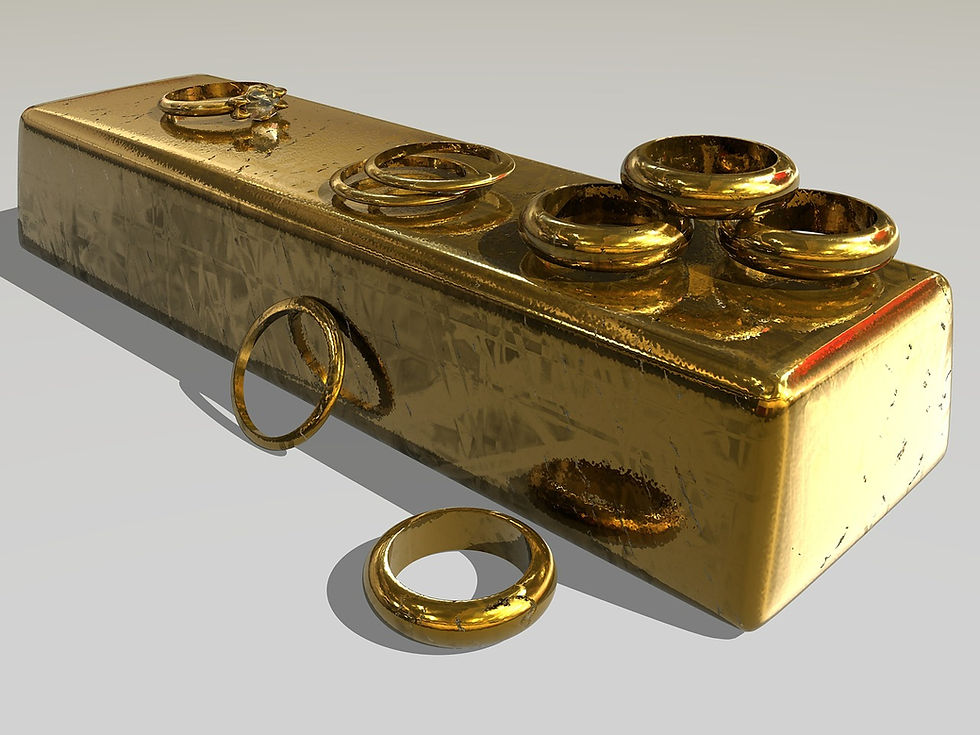Precious Metals Used in Jewellery
- Alyssum Jewellery
- Oct 9, 2018
- 7 min read
Traditionally, precious metals have been used in jewellery making for thousands of years – at least 8,000 in fact! Ancient eastern civilisations first began using precious metals in jewellery and decoration as far back as around 6000 BCE, with the choice of metals used dependent on what could be found locally, or sourced along trade routes. In Egypt gold was the metal of choice, whilst in China silver was more desirable. Over the millennia, we've added platinum, palladium and rhodium to the list too, with trends changing along the way according to fashion and availability. This week we take a look at the precious metals used in jewellery traditionally and today, across different cultures and changing trends.

Ancient Egyptian electrum gold (naturally occurring alloy of gold and silver) headband from around 1600BCE, possibly part of a dowry for an Egyptian princess.
WHAT IS A PRECIOUS METAL?
The word metal comes from the Latin metallum and Greek metallon, meaning loosely "To seek for" and probably more directly "to mine" or "quarry", so metal can be said to be something looked for in a mine. A precious metal is one that occurs naturally, is relatively rare, and therefore considered to be desirable and of high economic value.
GOLD

Gold was probably the first of the precious metals to be used in jewellery, and it's easy to see why. Gold never tarnishes so it would glimmer like the sun, with seemingly mystical properties to ancient civilisations. Ancient Egyptians believed gold was the flesh of the gods and it was not for the likes of the ordinary people. Only the pharaohs and other important dignitaries were allowed to wear and use gold.
Gold is also rather soft and easily worked, even with ancient tools and techniques. It was used in the creation of collars and torques (decorative neck rings), bracelets, and sometimes worked into a wire to create filigree earrings.
The purity of gold is measured in karats. Pure gold (considered 99.9% pure to allow for insignificant trace elements), is called 24 karat (k) gold, so anything less than 24k has another metal added to it to create an alloy. This is done because pure gold is soft, easily scratched, and malleable, so it can often be bent out of shape. In spite of this, 24 karat gold is the preference in jewellery manufacture in India and many other eastern countries. In ancient times only the very wealthy and most noble people could wear gold, and as they were hardly likely to be manual labourers they had no need to worry about their precious gold being at risk of bending or scratching. As gold became somewhat more affordable it also needed to become somewhat more durable too. Alloys of gold are used to create durability or differences of colour. Common alloys are copper and silver, with preferred purities being 22 karat gold (22 parts pure gold to 2 parts alloy metal, 91.7% pure), 18 karat gold, 14 karat gold, and down to 9 karat gold (9 parts pure gold to 15 parts other metals, 41% pure).
YELLOW GOLD

24 karat gold is the brightest and richest of the yellow gold colours available. The more alloy that's added, the less bright and 'warm' the colour will become. In jewellery manufacture, this is often overcome by plating a finished piece of jewellery in 24 karat gold to improve its colour whilst keeping the overall cost down. ROSE GOLD
Rose gold is simply yellow gold alloyed with a large amount of copper to give it its pinkish hue. The more copper in the alloy, the more rosy (but less pure!) the gold.
WHITE GOLD
White gold is yellow gold that has been alloyed with a white metal, such as nickel in the cheaper blends, or platinum or palladium in a more premium alloy. White gold is most often plated in rhodium to give it its gleaming bright shine, but over time as this plating wears off it reveals a duller white metal beneath. Bear in mind when buying gold jewellery, only yellow gold can be 24 karat gold. Rose gold and white gold are always alloyed with another metal and so cannot be pure 24 karat gold.
SILVER

Silver from the Kotowicki Treasure (early medieval/dark ages) found in Poland in 1972. Image attribution: By Pnapora [CC BY-SA 3.0 (https://creativecommons.org/licenses/by-sa/3.0)], from Wikimedia Commons
Archeologists have found evidence of silver smelting dating back to around 4000BCE, whilst gold had already been in use in jewellery manufacture for a few thousand years before that. Because silver tarnishes and usually needs to be smelted from an ore, it was probably discovered by accident after a significant fire event, or as a by-product of copper production. Silver was highly desirable in ancient civilisations because it was a lighter weight than gold and somewhat more durable, though still easily malleable and workable. Where gold was the sun, silver was the moon, and equally as precious and mystical. Silver was frequently used amongst the rich for more practical items, such as drinking vessels, cutlery, and plates – more civilised and grand than wooden platters or stale bread trenchers! It was also worked into jewellery and alloyed into gold for those wealthy enough for such trinkets, but not quite wealthy enough for pure gold. In ancient China, however, silver was prized culturally more highly than gold and was used in the production of coins.
Nowadays, it's very rare that you will find pure silver jewellery. Like gold, most silver is alloyed with another metal – usually copper or nickel – to create a more durable finish. Pure silver is a flatter colour than alloyed silver, and is recognised by the 999 stamp, meaning 99.9% pure. It's more common to find pure silver jewellery in Asian countries where pure metals are preferred over alloys.
STERLING SILVER
The most common silver available in jewellery stores is what we know as sterling silver. Sterling silver is internationally recognised by the 925 stamp, meaning it is 92.5% pure silver, and 7.5% other metal. The stamp is not always used, but it's a good indicator of the jewellery's authenticity.
Silver is known to tarnish over time but silver jewellery can be cleaned to something like its former glory (see our article on preserving your heirloom jewellery below for cleaning tips). Some sterling silver jewellery is plated in gold (a process known as vermeil), or rhodium to provide a tarnish-free shine. Nowadays, many jewellery manufacturers are adding an element called germanium to the alloys in silver to increase its resistance to tarnish.
TIBETAN SILVER
You may have seen the term 'Tibetan Silver' in reference to costume jewellery items, but this is likely to contain no real silver at all, or very little at best. The term simply references the colour of the metal and not the silver content. Pieces can be very pretty, but there is a gamble in not knowing the true metal content, which can lead to allergic reactions and sensitivity.
OTHER PRECIOUS METALS USED IN JEWELLERY
The other precious metals commonly used in jewellery are all from the platinum family: Platinum, Palladium, and Rhodium being the three most commonly used, with Osmium, Iridium and Ruthenium making up the other members of the group.
PLATINUM
Platinum is far rarer than gold – about 30x rarer – and is a far more recent discovery having been first noted in South America in 1735, though the South Americans had been using it for centuries! Deposits were not discovered in Europe until 1823 and so platinum was not used in ancient European, African or Asian jewellery. Platinum is considered the 'rich man's gold' because ten tonnes of ore must be mined to yield just one ounce (28 grams) of pure platinum in a process that takes months. In fact, all the platinum ever mined so far would only fill one standard sized living room! Platinum has a bright silvery-white shine and doesn't tarnish. It's also reasonably durable but is best alloyed with other metals to at least 92.5%, like silver, to create a truly durable product for higher impact jewellery like rings and bracelets.
PALLADIUM

Palladium was discovered in 1802 and it's a tricky metal to describe chemically. English chemist William H Wollaston discovered the product when examining residue left after the ore extraction process of platinum. Like platinum it's a bright silvery-white metal, but far more expensive because of the extraction and casting processes. In jewellery it is more commonly used as an alloy to create white gold as its brightness doesn't require rhodium plating, though pure palladium (999) and palladium alloys are becoming more frequently used in the luxury jewellery market.
Palladium ring "After The Rain" by Joanna Angelett, palladium jewellery award winner, 2010. [CC BY-SA 3.0 (https://creativecommons.org/licenses/by-sa/3.0)], via Wikimedia Commons,
RHODIUM
Rhodium was also discovered by William H Wollaston around the same time that he discovered palladium, in 1803. Rhodium is the rarest element of the platinum family and the most expensive to buy. If ever pure rhodium is used in a jewellery piece it would purely be for a one-off display piece and likely too valuable to ever be worn.
As a precious metal, rhodium is tarnish and corrosion proof and resistant to most acids. It's commonly used as an alloy added to platinum jewellery, or as a plating in other jewellery applications to add a durable high-shine silvery-white finish.
Some of the jewellery in our bridal range and premiere crystal range is rhodium plated for shine and quality. PRECIOUS JEWELLERY METALS RANKED BY RARITY
The results might surprise you!
RHODIUM
PLATINUM
GOLD
Ruthenium
Iridium
Osmium
PALLADIUM
SILVER
PRECIOUS JEWELLERY METALS RANKED BY EXPENSE
Bear in mind that values fluctuate according to trends and market factors, and the order in this list is subject to change, but generally the order of precious metals used in jewellery by value is:
Osmium
RHODIUM
PLATINUM
GOLD
PALLADIUM
Iridium
Rhuthenium
SILVER
Next week: "Gemology: Gemstones Beginning With U..."








































Comments